Leading Change: Analyzing Strategies, Impacts, and Barriers Report
VerifiedAdded on 2020/10/22
|14
|4370
|85
Report
AI Summary
This report provides a detailed analysis of leading change within organizations, focusing on the retail sector, specifically ASDA and Sainsbury's. It explores the impact of changes on organizational strategies and operations, differentiating between planned and unplanned changes, and examining political, environmental, and technological factors. The report also investigates internal and external drivers of change and their effects on leadership, team, and individual behavior, comparing proactive and reactive leadership approaches. Furthermore, it delves into various barriers to change and how they influence leadership decision-making, while also evaluating different leadership approaches to manage change. Finally, the report outlines measures that can be taken to minimize the negative impacts of change on organizational behavior, such as clear communication, training, employee participation, and effective time management. This report offers valuable insights into managing and leading change effectively within a business context.
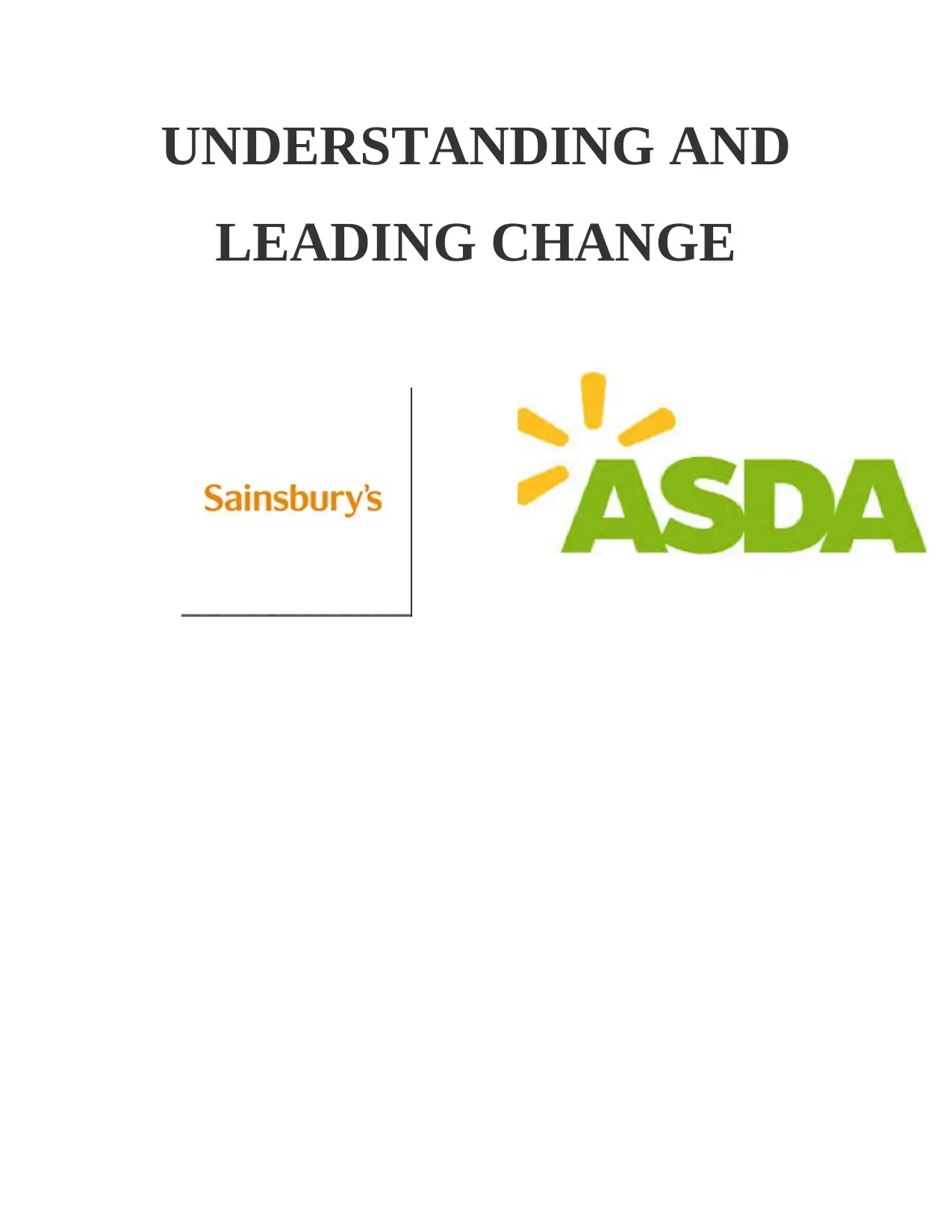
UNDERSTANDING AND
LEADING CHANGE
LEADING CHANGE
Paraphrase This Document
Need a fresh take? Get an instant paraphrase of this document with our AI Paraphraser
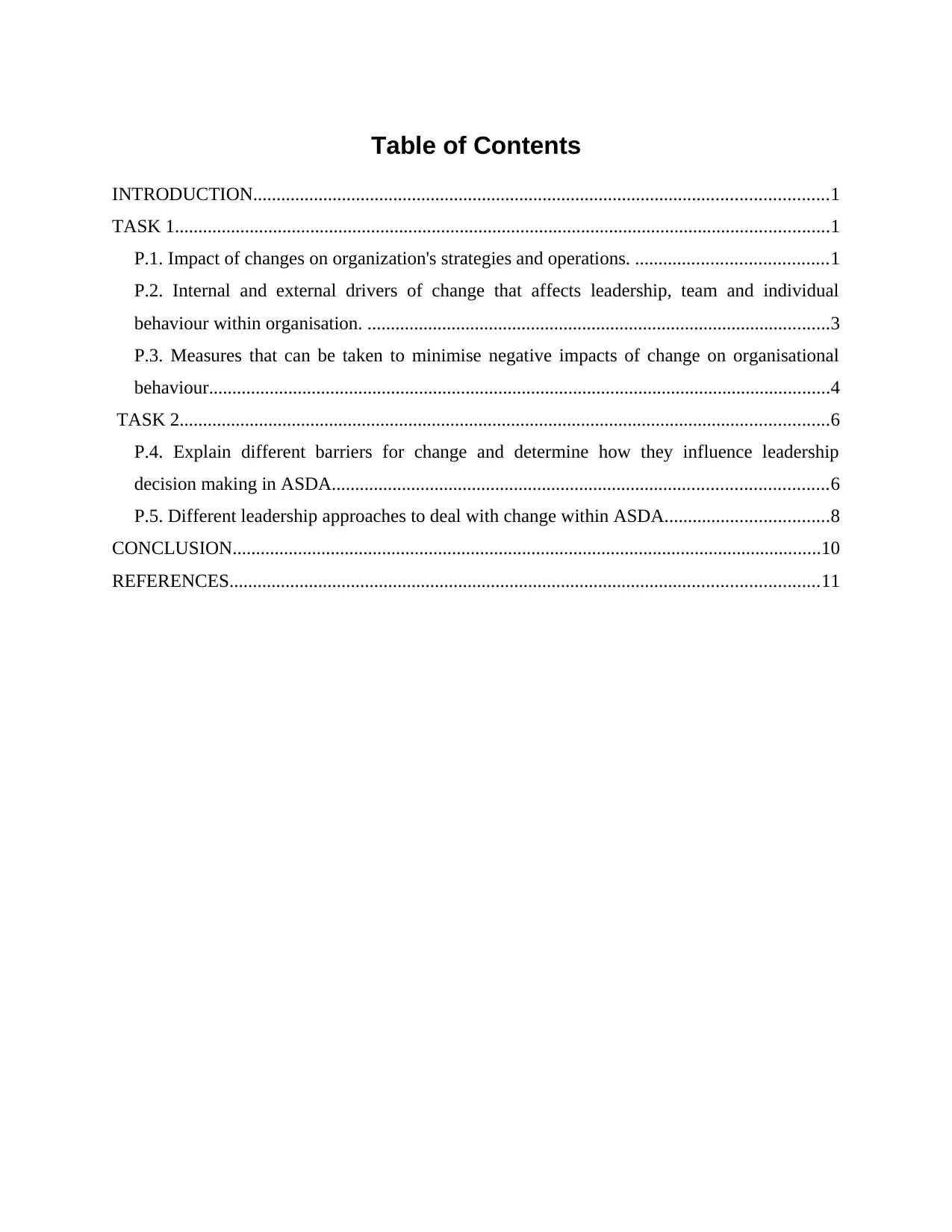
Table of Contents
INTRODUCTION...........................................................................................................................1
TASK 1............................................................................................................................................1
P.1. Impact of changes on organization's strategies and operations. .........................................1
P.2. Internal and external drivers of change that affects leadership, team and individual
behaviour within organisation. ...................................................................................................3
P.3. Measures that can be taken to minimise negative impacts of change on organisational
behaviour.....................................................................................................................................4
TASK 2...........................................................................................................................................6
P.4. Explain different barriers for change and determine how they influence leadership
decision making in ASDA..........................................................................................................6
P.5. Different leadership approaches to deal with change within ASDA...................................8
CONCLUSION..............................................................................................................................10
REFERENCES..............................................................................................................................11
INTRODUCTION...........................................................................................................................1
TASK 1............................................................................................................................................1
P.1. Impact of changes on organization's strategies and operations. .........................................1
P.2. Internal and external drivers of change that affects leadership, team and individual
behaviour within organisation. ...................................................................................................3
P.3. Measures that can be taken to minimise negative impacts of change on organisational
behaviour.....................................................................................................................................4
TASK 2...........................................................................................................................................6
P.4. Explain different barriers for change and determine how they influence leadership
decision making in ASDA..........................................................................................................6
P.5. Different leadership approaches to deal with change within ASDA...................................8
CONCLUSION..............................................................................................................................10
REFERENCES..............................................................................................................................11
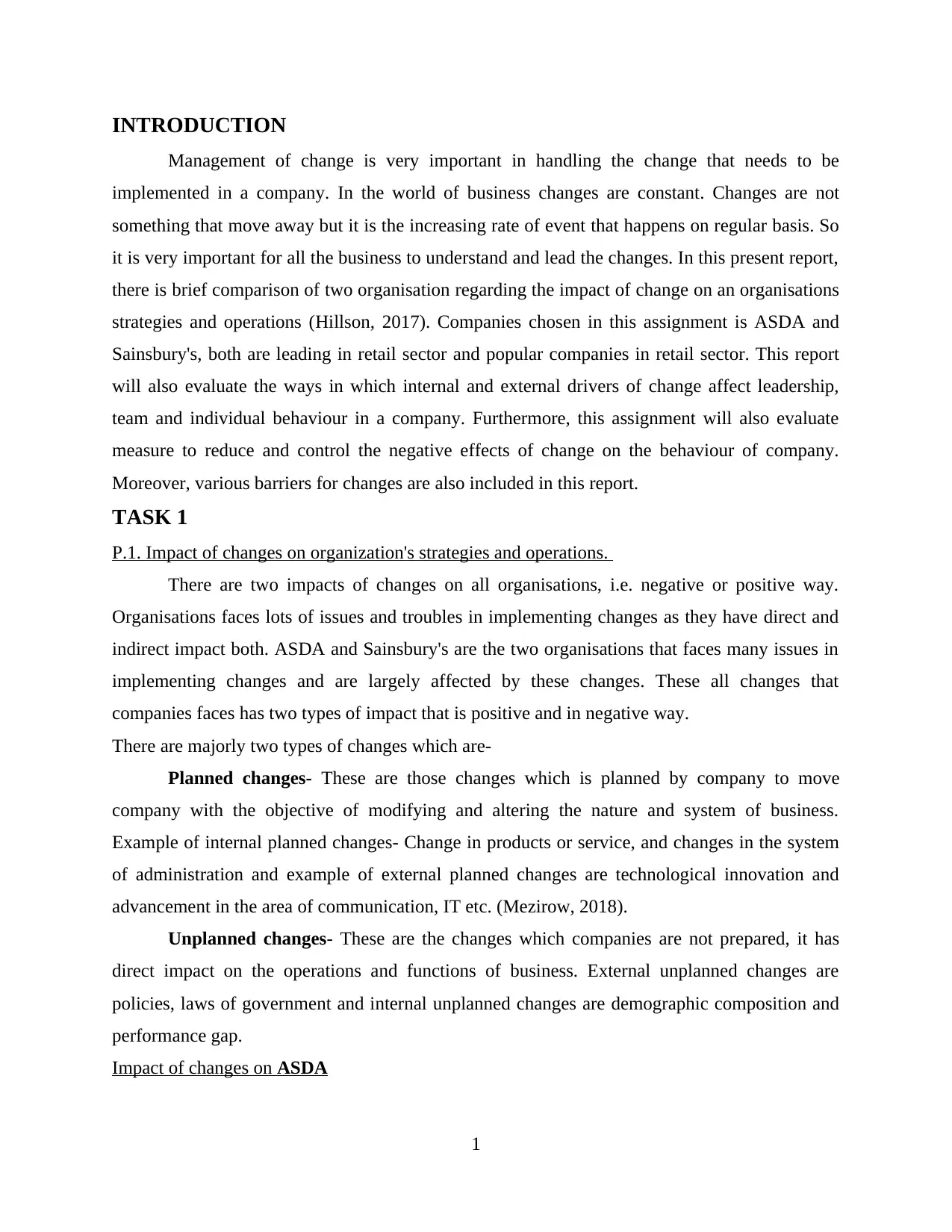
INTRODUCTION
Management of change is very important in handling the change that needs to be
implemented in a company. In the world of business changes are constant. Changes are not
something that move away but it is the increasing rate of event that happens on regular basis. So
it is very important for all the business to understand and lead the changes. In this present report,
there is brief comparison of two organisation regarding the impact of change on an organisations
strategies and operations (Hillson, 2017). Companies chosen in this assignment is ASDA and
Sainsbury's, both are leading in retail sector and popular companies in retail sector. This report
will also evaluate the ways in which internal and external drivers of change affect leadership,
team and individual behaviour in a company. Furthermore, this assignment will also evaluate
measure to reduce and control the negative effects of change on the behaviour of company.
Moreover, various barriers for changes are also included in this report.
TASK 1
P.1. Impact of changes on organization's strategies and operations.
There are two impacts of changes on all organisations, i.e. negative or positive way.
Organisations faces lots of issues and troubles in implementing changes as they have direct and
indirect impact both. ASDA and Sainsbury's are the two organisations that faces many issues in
implementing changes and are largely affected by these changes. These all changes that
companies faces has two types of impact that is positive and in negative way.
There are majorly two types of changes which are-
Planned changes- These are those changes which is planned by company to move
company with the objective of modifying and altering the nature and system of business.
Example of internal planned changes- Change in products or service, and changes in the system
of administration and example of external planned changes are technological innovation and
advancement in the area of communication, IT etc. (Mezirow, 2018).
Unplanned changes- These are the changes which companies are not prepared, it has
direct impact on the operations and functions of business. External unplanned changes are
policies, laws of government and internal unplanned changes are demographic composition and
performance gap.
Impact of changes on ASDA
1
Management of change is very important in handling the change that needs to be
implemented in a company. In the world of business changes are constant. Changes are not
something that move away but it is the increasing rate of event that happens on regular basis. So
it is very important for all the business to understand and lead the changes. In this present report,
there is brief comparison of two organisation regarding the impact of change on an organisations
strategies and operations (Hillson, 2017). Companies chosen in this assignment is ASDA and
Sainsbury's, both are leading in retail sector and popular companies in retail sector. This report
will also evaluate the ways in which internal and external drivers of change affect leadership,
team and individual behaviour in a company. Furthermore, this assignment will also evaluate
measure to reduce and control the negative effects of change on the behaviour of company.
Moreover, various barriers for changes are also included in this report.
TASK 1
P.1. Impact of changes on organization's strategies and operations.
There are two impacts of changes on all organisations, i.e. negative or positive way.
Organisations faces lots of issues and troubles in implementing changes as they have direct and
indirect impact both. ASDA and Sainsbury's are the two organisations that faces many issues in
implementing changes and are largely affected by these changes. These all changes that
companies faces has two types of impact that is positive and in negative way.
There are majorly two types of changes which are-
Planned changes- These are those changes which is planned by company to move
company with the objective of modifying and altering the nature and system of business.
Example of internal planned changes- Change in products or service, and changes in the system
of administration and example of external planned changes are technological innovation and
advancement in the area of communication, IT etc. (Mezirow, 2018).
Unplanned changes- These are the changes which companies are not prepared, it has
direct impact on the operations and functions of business. External unplanned changes are
policies, laws of government and internal unplanned changes are demographic composition and
performance gap.
Impact of changes on ASDA
1
⊘ This is a preview!⊘
Do you want full access?
Subscribe today to unlock all pages.

Trusted by 1+ million students worldwide
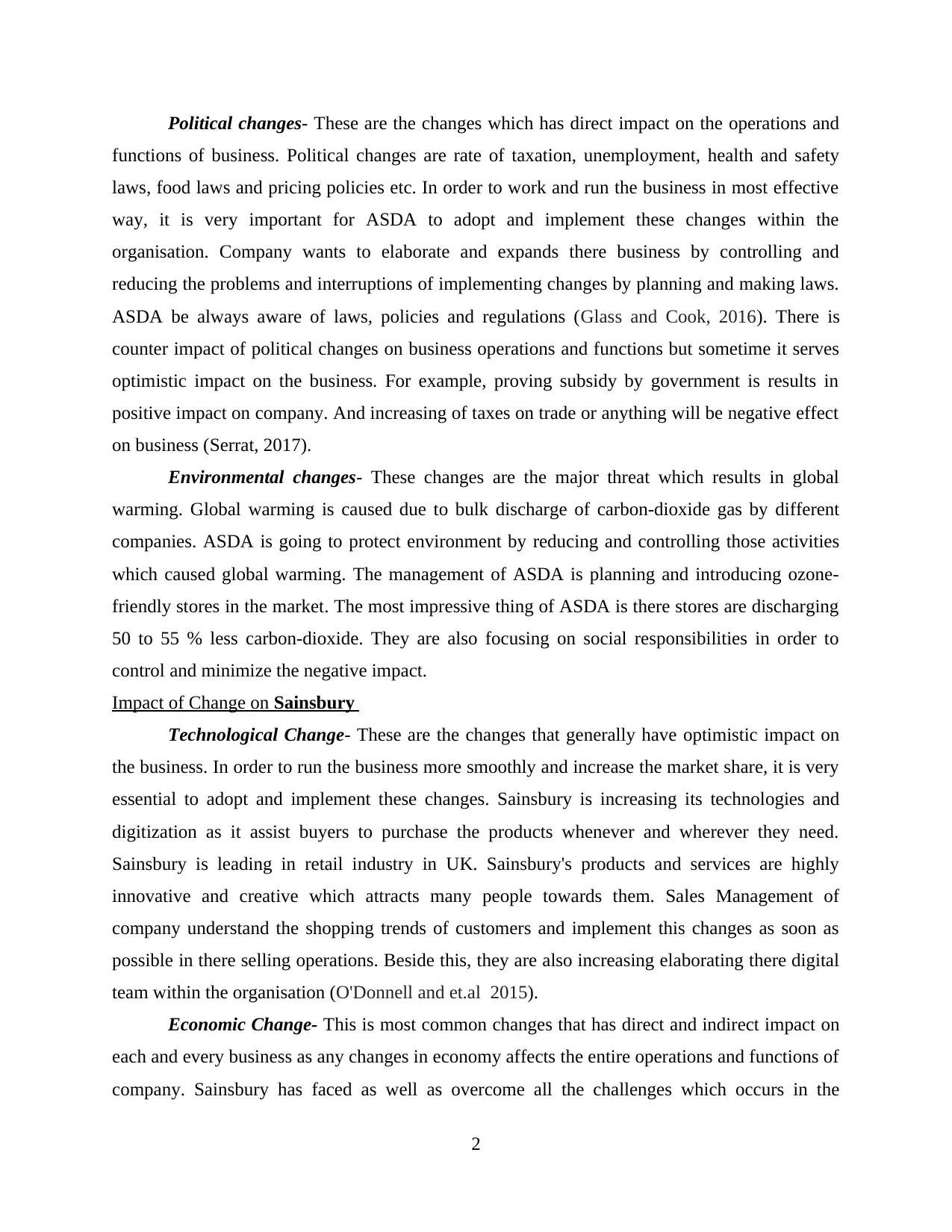
Political changes- These are the changes which has direct impact on the operations and
functions of business. Political changes are rate of taxation, unemployment, health and safety
laws, food laws and pricing policies etc. In order to work and run the business in most effective
way, it is very important for ASDA to adopt and implement these changes within the
organisation. Company wants to elaborate and expands there business by controlling and
reducing the problems and interruptions of implementing changes by planning and making laws.
ASDA be always aware of laws, policies and regulations (Glass and Cook, 2016). There is
counter impact of political changes on business operations and functions but sometime it serves
optimistic impact on the business. For example, proving subsidy by government is results in
positive impact on company. And increasing of taxes on trade or anything will be negative effect
on business (Serrat, 2017).
Environmental changes- These changes are the major threat which results in global
warming. Global warming is caused due to bulk discharge of carbon-dioxide gas by different
companies. ASDA is going to protect environment by reducing and controlling those activities
which caused global warming. The management of ASDA is planning and introducing ozone-
friendly stores in the market. The most impressive thing of ASDA is there stores are discharging
50 to 55 % less carbon-dioxide. They are also focusing on social responsibilities in order to
control and minimize the negative impact.
Impact of Change on Sainsbury
Technological Change- These are the changes that generally have optimistic impact on
the business. In order to run the business more smoothly and increase the market share, it is very
essential to adopt and implement these changes. Sainsbury is increasing its technologies and
digitization as it assist buyers to purchase the products whenever and wherever they need.
Sainsbury is leading in retail industry in UK. Sainsbury's products and services are highly
innovative and creative which attracts many people towards them. Sales Management of
company understand the shopping trends of customers and implement this changes as soon as
possible in there selling operations. Beside this, they are also increasing elaborating there digital
team within the organisation (O'Donnell and et.al 2015).
Economic Change- This is most common changes that has direct and indirect impact on
each and every business as any changes in economy affects the entire operations and functions of
company. Sainsbury has faced as well as overcome all the challenges which occurs in the
2
functions of business. Political changes are rate of taxation, unemployment, health and safety
laws, food laws and pricing policies etc. In order to work and run the business in most effective
way, it is very important for ASDA to adopt and implement these changes within the
organisation. Company wants to elaborate and expands there business by controlling and
reducing the problems and interruptions of implementing changes by planning and making laws.
ASDA be always aware of laws, policies and regulations (Glass and Cook, 2016). There is
counter impact of political changes on business operations and functions but sometime it serves
optimistic impact on the business. For example, proving subsidy by government is results in
positive impact on company. And increasing of taxes on trade or anything will be negative effect
on business (Serrat, 2017).
Environmental changes- These changes are the major threat which results in global
warming. Global warming is caused due to bulk discharge of carbon-dioxide gas by different
companies. ASDA is going to protect environment by reducing and controlling those activities
which caused global warming. The management of ASDA is planning and introducing ozone-
friendly stores in the market. The most impressive thing of ASDA is there stores are discharging
50 to 55 % less carbon-dioxide. They are also focusing on social responsibilities in order to
control and minimize the negative impact.
Impact of Change on Sainsbury
Technological Change- These are the changes that generally have optimistic impact on
the business. In order to run the business more smoothly and increase the market share, it is very
essential to adopt and implement these changes. Sainsbury is increasing its technologies and
digitization as it assist buyers to purchase the products whenever and wherever they need.
Sainsbury is leading in retail industry in UK. Sainsbury's products and services are highly
innovative and creative which attracts many people towards them. Sales Management of
company understand the shopping trends of customers and implement this changes as soon as
possible in there selling operations. Beside this, they are also increasing elaborating there digital
team within the organisation (O'Donnell and et.al 2015).
Economic Change- This is most common changes that has direct and indirect impact on
each and every business as any changes in economy affects the entire operations and functions of
company. Sainsbury has faced as well as overcome all the challenges which occurs in the
2
Paraphrase This Document
Need a fresh take? Get an instant paraphrase of this document with our AI Paraphraser
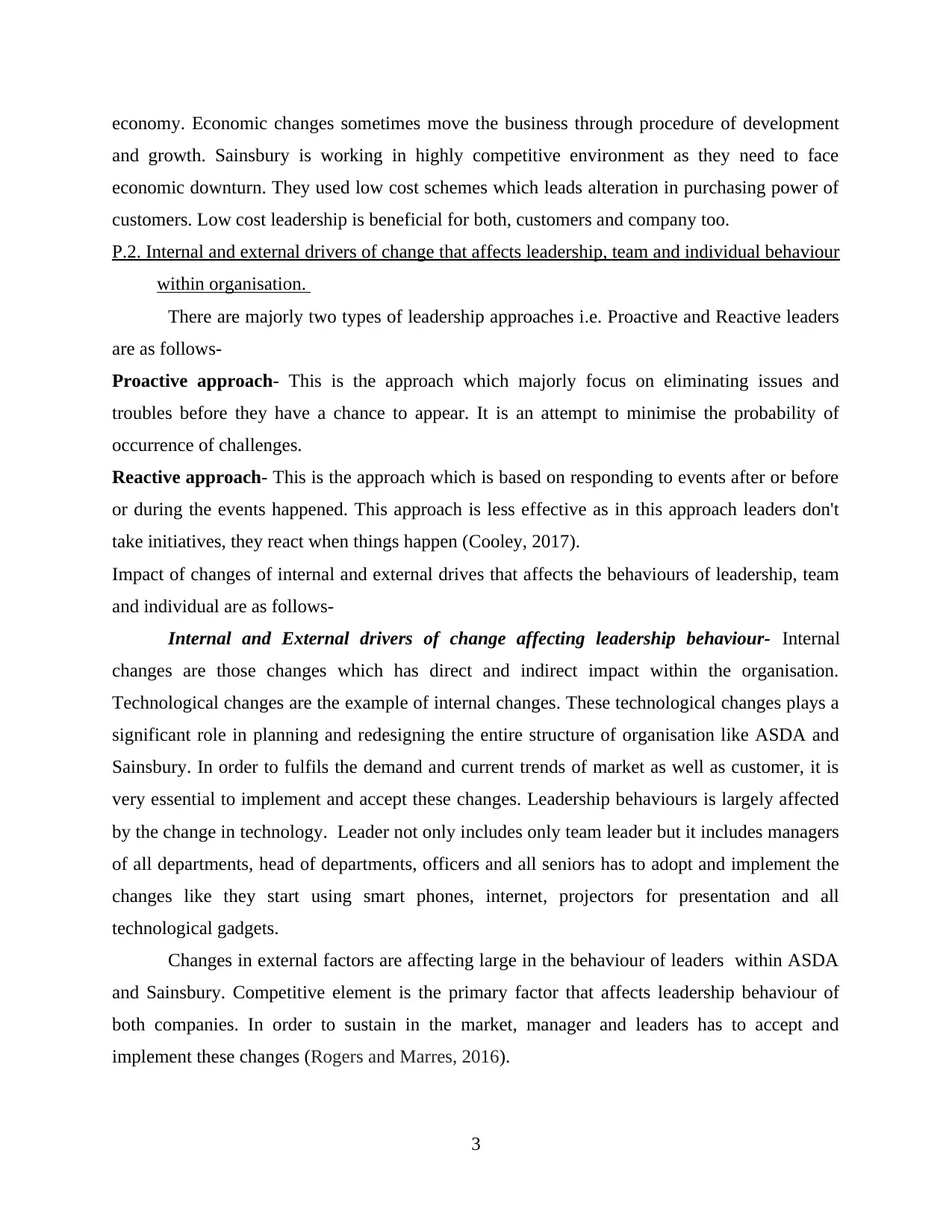
economy. Economic changes sometimes move the business through procedure of development
and growth. Sainsbury is working in highly competitive environment as they need to face
economic downturn. They used low cost schemes which leads alteration in purchasing power of
customers. Low cost leadership is beneficial for both, customers and company too.
P.2. Internal and external drivers of change that affects leadership, team and individual behaviour
within organisation.
There are majorly two types of leadership approaches i.e. Proactive and Reactive leaders
are as follows-
Proactive approach- This is the approach which majorly focus on eliminating issues and
troubles before they have a chance to appear. It is an attempt to minimise the probability of
occurrence of challenges.
Reactive approach- This is the approach which is based on responding to events after or before
or during the events happened. This approach is less effective as in this approach leaders don't
take initiatives, they react when things happen (Cooley, 2017).
Impact of changes of internal and external drives that affects the behaviours of leadership, team
and individual are as follows-
Internal and External drivers of change affecting leadership behaviour- Internal
changes are those changes which has direct and indirect impact within the organisation.
Technological changes are the example of internal changes. These technological changes plays a
significant role in planning and redesigning the entire structure of organisation like ASDA and
Sainsbury. In order to fulfils the demand and current trends of market as well as customer, it is
very essential to implement and accept these changes. Leadership behaviours is largely affected
by the change in technology. Leader not only includes only team leader but it includes managers
of all departments, head of departments, officers and all seniors has to adopt and implement the
changes like they start using smart phones, internet, projectors for presentation and all
technological gadgets.
Changes in external factors are affecting large in the behaviour of leaders within ASDA
and Sainsbury. Competitive element is the primary factor that affects leadership behaviour of
both companies. In order to sustain in the market, manager and leaders has to accept and
implement these changes (Rogers and Marres, 2016).
3
and growth. Sainsbury is working in highly competitive environment as they need to face
economic downturn. They used low cost schemes which leads alteration in purchasing power of
customers. Low cost leadership is beneficial for both, customers and company too.
P.2. Internal and external drivers of change that affects leadership, team and individual behaviour
within organisation.
There are majorly two types of leadership approaches i.e. Proactive and Reactive leaders
are as follows-
Proactive approach- This is the approach which majorly focus on eliminating issues and
troubles before they have a chance to appear. It is an attempt to minimise the probability of
occurrence of challenges.
Reactive approach- This is the approach which is based on responding to events after or before
or during the events happened. This approach is less effective as in this approach leaders don't
take initiatives, they react when things happen (Cooley, 2017).
Impact of changes of internal and external drives that affects the behaviours of leadership, team
and individual are as follows-
Internal and External drivers of change affecting leadership behaviour- Internal
changes are those changes which has direct and indirect impact within the organisation.
Technological changes are the example of internal changes. These technological changes plays a
significant role in planning and redesigning the entire structure of organisation like ASDA and
Sainsbury. In order to fulfils the demand and current trends of market as well as customer, it is
very essential to implement and accept these changes. Leadership behaviours is largely affected
by the change in technology. Leader not only includes only team leader but it includes managers
of all departments, head of departments, officers and all seniors has to adopt and implement the
changes like they start using smart phones, internet, projectors for presentation and all
technological gadgets.
Changes in external factors are affecting large in the behaviour of leaders within ASDA
and Sainsbury. Competitive element is the primary factor that affects leadership behaviour of
both companies. In order to sustain in the market, manager and leaders has to accept and
implement these changes (Rogers and Marres, 2016).
3
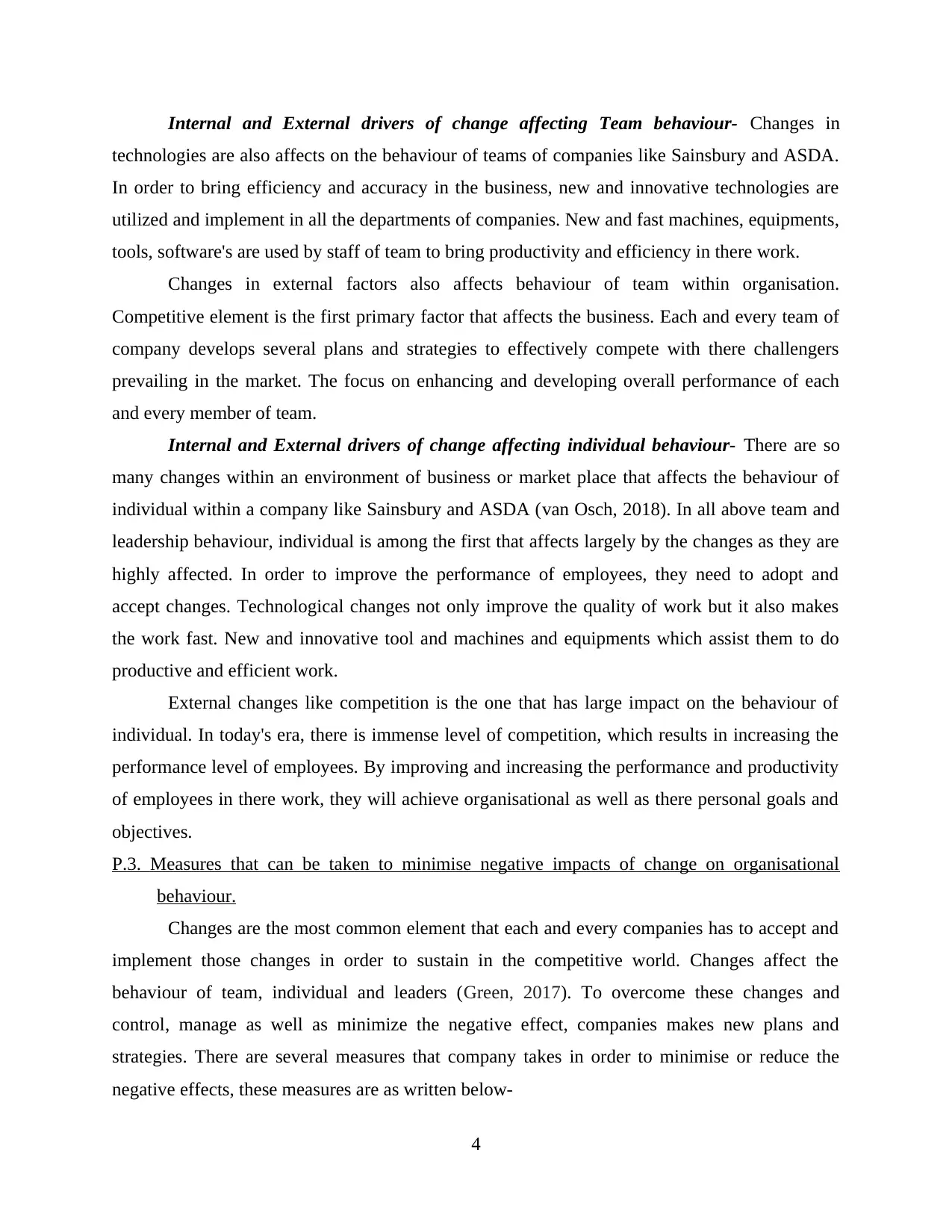
Internal and External drivers of change affecting Team behaviour- Changes in
technologies are also affects on the behaviour of teams of companies like Sainsbury and ASDA.
In order to bring efficiency and accuracy in the business, new and innovative technologies are
utilized and implement in all the departments of companies. New and fast machines, equipments,
tools, software's are used by staff of team to bring productivity and efficiency in there work.
Changes in external factors also affects behaviour of team within organisation.
Competitive element is the first primary factor that affects the business. Each and every team of
company develops several plans and strategies to effectively compete with there challengers
prevailing in the market. The focus on enhancing and developing overall performance of each
and every member of team.
Internal and External drivers of change affecting individual behaviour- There are so
many changes within an environment of business or market place that affects the behaviour of
individual within a company like Sainsbury and ASDA (van Osch, 2018). In all above team and
leadership behaviour, individual is among the first that affects largely by the changes as they are
highly affected. In order to improve the performance of employees, they need to adopt and
accept changes. Technological changes not only improve the quality of work but it also makes
the work fast. New and innovative tool and machines and equipments which assist them to do
productive and efficient work.
External changes like competition is the one that has large impact on the behaviour of
individual. In today's era, there is immense level of competition, which results in increasing the
performance level of employees. By improving and increasing the performance and productivity
of employees in there work, they will achieve organisational as well as there personal goals and
objectives.
P.3. Measures that can be taken to minimise negative impacts of change on organisational
behaviour.
Changes are the most common element that each and every companies has to accept and
implement those changes in order to sustain in the competitive world. Changes affect the
behaviour of team, individual and leaders (Green, 2017). To overcome these changes and
control, manage as well as minimize the negative effect, companies makes new plans and
strategies. There are several measures that company takes in order to minimise or reduce the
negative effects, these measures are as written below-
4
technologies are also affects on the behaviour of teams of companies like Sainsbury and ASDA.
In order to bring efficiency and accuracy in the business, new and innovative technologies are
utilized and implement in all the departments of companies. New and fast machines, equipments,
tools, software's are used by staff of team to bring productivity and efficiency in there work.
Changes in external factors also affects behaviour of team within organisation.
Competitive element is the first primary factor that affects the business. Each and every team of
company develops several plans and strategies to effectively compete with there challengers
prevailing in the market. The focus on enhancing and developing overall performance of each
and every member of team.
Internal and External drivers of change affecting individual behaviour- There are so
many changes within an environment of business or market place that affects the behaviour of
individual within a company like Sainsbury and ASDA (van Osch, 2018). In all above team and
leadership behaviour, individual is among the first that affects largely by the changes as they are
highly affected. In order to improve the performance of employees, they need to adopt and
accept changes. Technological changes not only improve the quality of work but it also makes
the work fast. New and innovative tool and machines and equipments which assist them to do
productive and efficient work.
External changes like competition is the one that has large impact on the behaviour of
individual. In today's era, there is immense level of competition, which results in increasing the
performance level of employees. By improving and increasing the performance and productivity
of employees in there work, they will achieve organisational as well as there personal goals and
objectives.
P.3. Measures that can be taken to minimise negative impacts of change on organisational
behaviour.
Changes are the most common element that each and every companies has to accept and
implement those changes in order to sustain in the competitive world. Changes affect the
behaviour of team, individual and leaders (Green, 2017). To overcome these changes and
control, manage as well as minimize the negative effect, companies makes new plans and
strategies. There are several measures that company takes in order to minimise or reduce the
negative effects, these measures are as written below-
4
⊘ This is a preview!⊘
Do you want full access?
Subscribe today to unlock all pages.

Trusted by 1+ million students worldwide
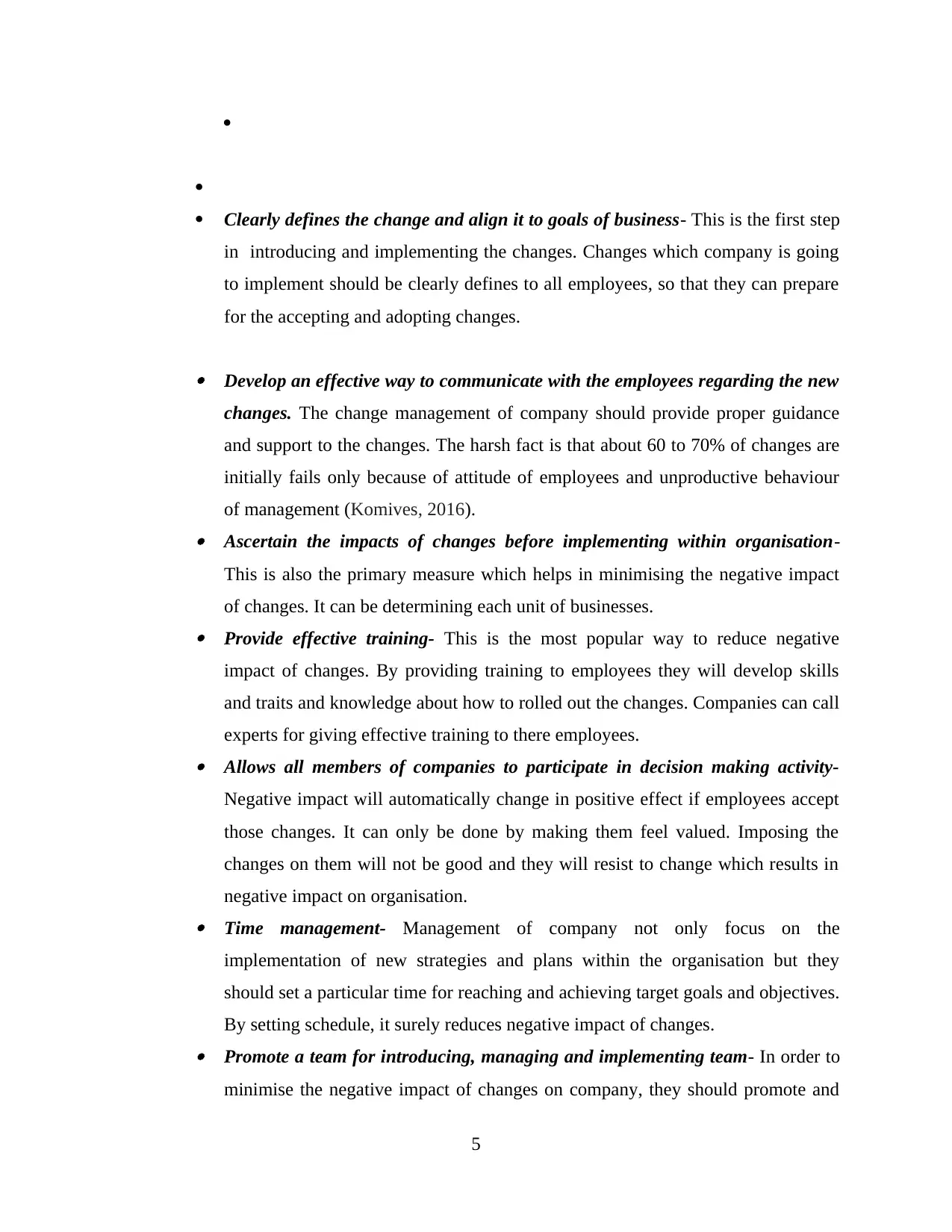
Clearly defines the change and align it to goals of business- This is the first step
in introducing and implementing the changes. Changes which company is going
to implement should be clearly defines to all employees, so that they can prepare
for the accepting and adopting changes.
Develop an effective way to communicate with the employees regarding the new
changes. The change management of company should provide proper guidance
and support to the changes. The harsh fact is that about 60 to 70% of changes are
initially fails only because of attitude of employees and unproductive behaviour
of management (Komives, 2016).
Ascertain the impacts of changes before implementing within organisation-
This is also the primary measure which helps in minimising the negative impact
of changes. It can be determining each unit of businesses.
Provide effective training- This is the most popular way to reduce negative
impact of changes. By providing training to employees they will develop skills
and traits and knowledge about how to rolled out the changes. Companies can call
experts for giving effective training to there employees.
Allows all members of companies to participate in decision making activity-
Negative impact will automatically change in positive effect if employees accept
those changes. It can only be done by making them feel valued. Imposing the
changes on them will not be good and they will resist to change which results in
negative impact on organisation.
Time management- Management of company not only focus on the
implementation of new strategies and plans within the organisation but they
should set a particular time for reaching and achieving target goals and objectives.
By setting schedule, it surely reduces negative impact of changes.
Promote a team for introducing, managing and implementing team- In order to
minimise the negative impact of changes on company, they should promote and
5
Clearly defines the change and align it to goals of business- This is the first step
in introducing and implementing the changes. Changes which company is going
to implement should be clearly defines to all employees, so that they can prepare
for the accepting and adopting changes.
Develop an effective way to communicate with the employees regarding the new
changes. The change management of company should provide proper guidance
and support to the changes. The harsh fact is that about 60 to 70% of changes are
initially fails only because of attitude of employees and unproductive behaviour
of management (Komives, 2016).
Ascertain the impacts of changes before implementing within organisation-
This is also the primary measure which helps in minimising the negative impact
of changes. It can be determining each unit of businesses.
Provide effective training- This is the most popular way to reduce negative
impact of changes. By providing training to employees they will develop skills
and traits and knowledge about how to rolled out the changes. Companies can call
experts for giving effective training to there employees.
Allows all members of companies to participate in decision making activity-
Negative impact will automatically change in positive effect if employees accept
those changes. It can only be done by making them feel valued. Imposing the
changes on them will not be good and they will resist to change which results in
negative impact on organisation.
Time management- Management of company not only focus on the
implementation of new strategies and plans within the organisation but they
should set a particular time for reaching and achieving target goals and objectives.
By setting schedule, it surely reduces negative impact of changes.
Promote a team for introducing, managing and implementing team- In order to
minimise the negative impact of changes on company, they should promote and
5
Paraphrase This Document
Need a fresh take? Get an instant paraphrase of this document with our AI Paraphraser
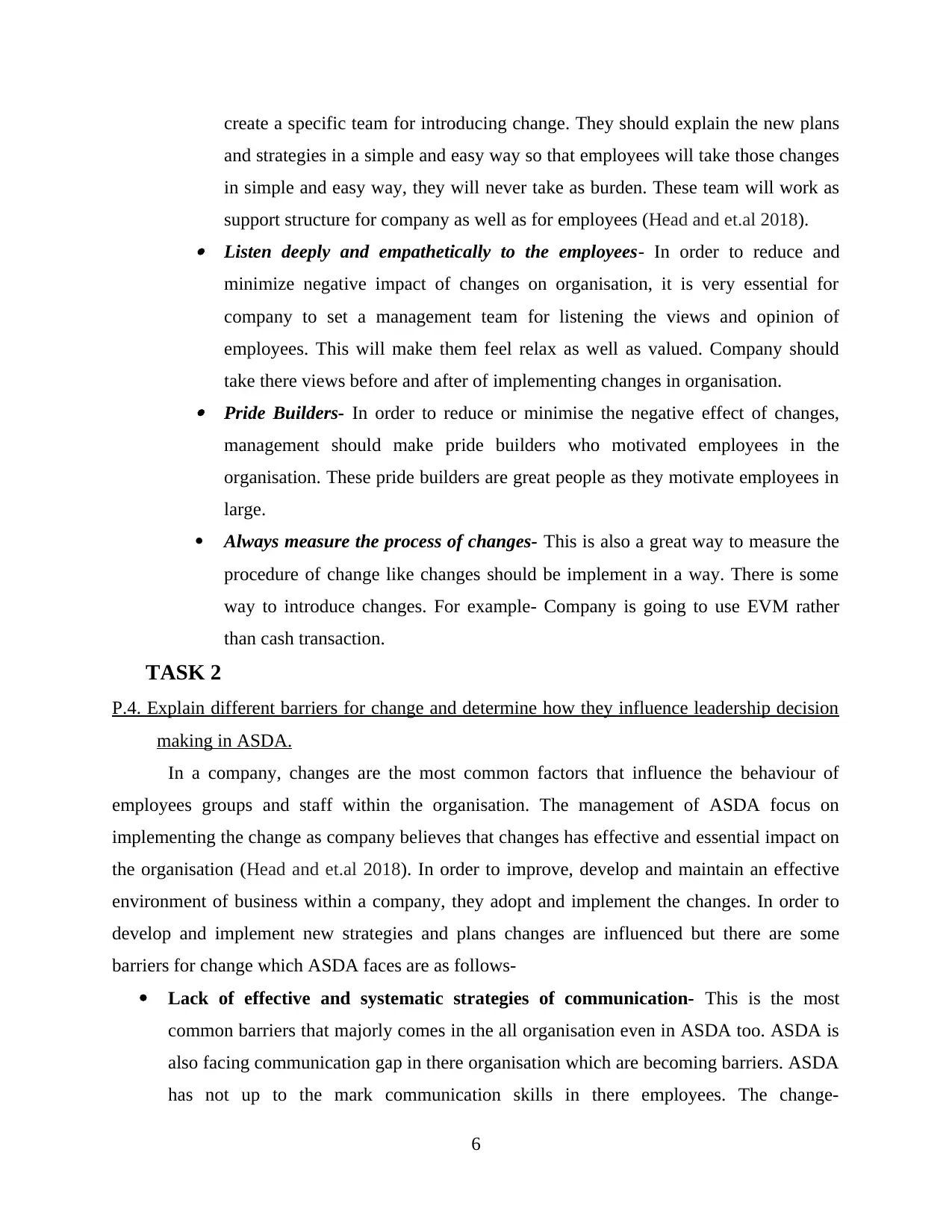
create a specific team for introducing change. They should explain the new plans
and strategies in a simple and easy way so that employees will take those changes
in simple and easy way, they will never take as burden. These team will work as
support structure for company as well as for employees (Head and et.al 2018).
Listen deeply and empathetically to the employees- In order to reduce and
minimize negative impact of changes on organisation, it is very essential for
company to set a management team for listening the views and opinion of
employees. This will make them feel relax as well as valued. Company should
take there views before and after of implementing changes in organisation.
Pride Builders- In order to reduce or minimise the negative effect of changes,
management should make pride builders who motivated employees in the
organisation. These pride builders are great people as they motivate employees in
large.
Always measure the process of changes- This is also a great way to measure the
procedure of change like changes should be implement in a way. There is some
way to introduce changes. For example- Company is going to use EVM rather
than cash transaction.
TASK 2
P.4. Explain different barriers for change and determine how they influence leadership decision
making in ASDA.
In a company, changes are the most common factors that influence the behaviour of
employees groups and staff within the organisation. The management of ASDA focus on
implementing the change as company believes that changes has effective and essential impact on
the organisation (Head and et.al 2018). In order to improve, develop and maintain an effective
environment of business within a company, they adopt and implement the changes. In order to
develop and implement new strategies and plans changes are influenced but there are some
barriers for change which ASDA faces are as follows-
Lack of effective and systematic strategies of communication- This is the most
common barriers that majorly comes in the all organisation even in ASDA too. ASDA is
also facing communication gap in there organisation which are becoming barriers. ASDA
has not up to the mark communication skills in there employees. The change-
6
and strategies in a simple and easy way so that employees will take those changes
in simple and easy way, they will never take as burden. These team will work as
support structure for company as well as for employees (Head and et.al 2018).
Listen deeply and empathetically to the employees- In order to reduce and
minimize negative impact of changes on organisation, it is very essential for
company to set a management team for listening the views and opinion of
employees. This will make them feel relax as well as valued. Company should
take there views before and after of implementing changes in organisation.
Pride Builders- In order to reduce or minimise the negative effect of changes,
management should make pride builders who motivated employees in the
organisation. These pride builders are great people as they motivate employees in
large.
Always measure the process of changes- This is also a great way to measure the
procedure of change like changes should be implement in a way. There is some
way to introduce changes. For example- Company is going to use EVM rather
than cash transaction.
TASK 2
P.4. Explain different barriers for change and determine how they influence leadership decision
making in ASDA.
In a company, changes are the most common factors that influence the behaviour of
employees groups and staff within the organisation. The management of ASDA focus on
implementing the change as company believes that changes has effective and essential impact on
the organisation (Head and et.al 2018). In order to improve, develop and maintain an effective
environment of business within a company, they adopt and implement the changes. In order to
develop and implement new strategies and plans changes are influenced but there are some
barriers for change which ASDA faces are as follows-
Lack of effective and systematic strategies of communication- This is the most
common barriers that majorly comes in the all organisation even in ASDA too. ASDA is
also facing communication gap in there organisation which are becoming barriers. ASDA
has not up to the mark communication skills in there employees. The change-
6
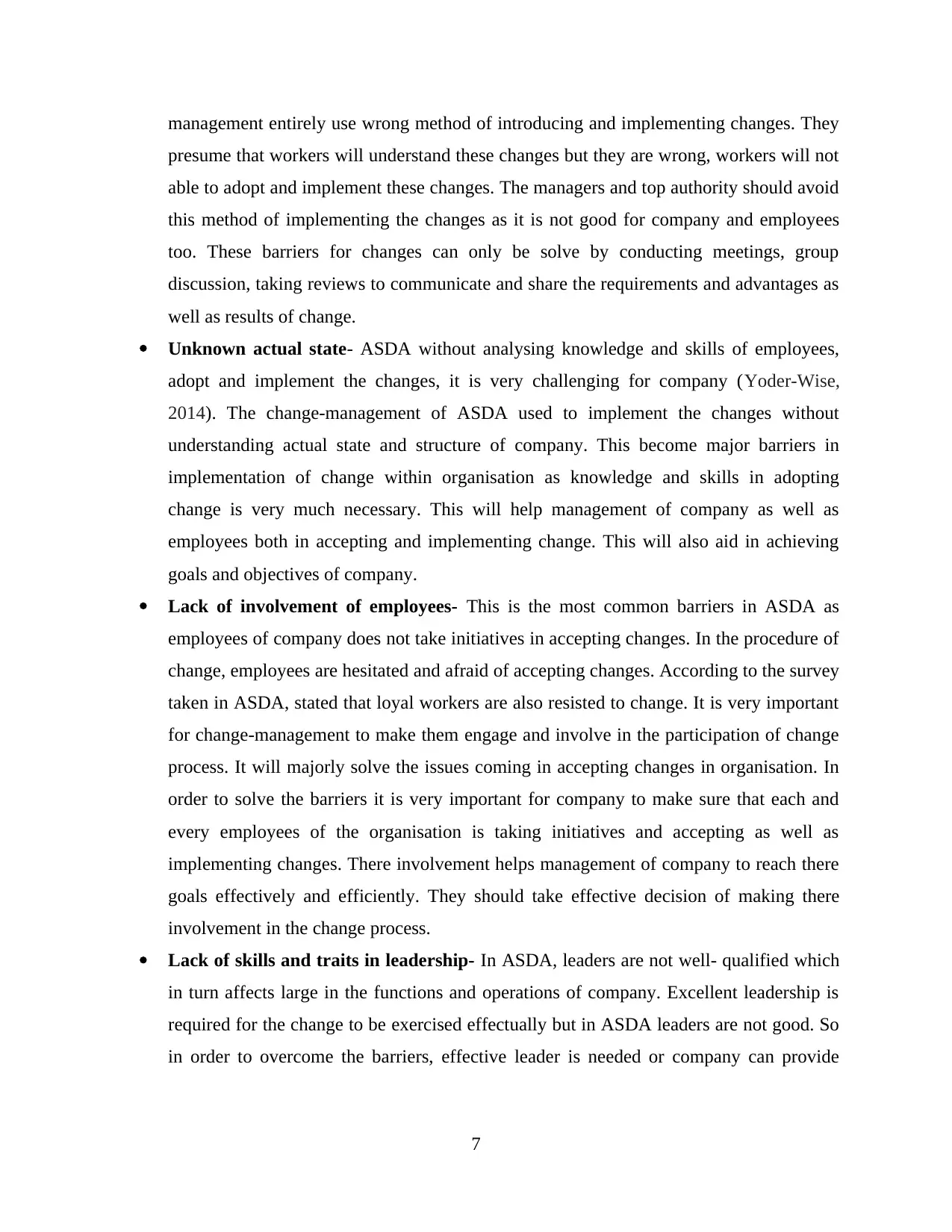
management entirely use wrong method of introducing and implementing changes. They
presume that workers will understand these changes but they are wrong, workers will not
able to adopt and implement these changes. The managers and top authority should avoid
this method of implementing the changes as it is not good for company and employees
too. These barriers for changes can only be solve by conducting meetings, group
discussion, taking reviews to communicate and share the requirements and advantages as
well as results of change.
Unknown actual state- ASDA without analysing knowledge and skills of employees,
adopt and implement the changes, it is very challenging for company (Yoder-Wise,
2014). The change-management of ASDA used to implement the changes without
understanding actual state and structure of company. This become major barriers in
implementation of change within organisation as knowledge and skills in adopting
change is very much necessary. This will help management of company as well as
employees both in accepting and implementing change. This will also aid in achieving
goals and objectives of company.
Lack of involvement of employees- This is the most common barriers in ASDA as
employees of company does not take initiatives in accepting changes. In the procedure of
change, employees are hesitated and afraid of accepting changes. According to the survey
taken in ASDA, stated that loyal workers are also resisted to change. It is very important
for change-management to make them engage and involve in the participation of change
process. It will majorly solve the issues coming in accepting changes in organisation. In
order to solve the barriers it is very important for company to make sure that each and
every employees of the organisation is taking initiatives and accepting as well as
implementing changes. There involvement helps management of company to reach there
goals effectively and efficiently. They should take effective decision of making there
involvement in the change process.
Lack of skills and traits in leadership- In ASDA, leaders are not well- qualified which
in turn affects large in the functions and operations of company. Excellent leadership is
required for the change to be exercised effectually but in ASDA leaders are not good. So
in order to overcome the barriers, effective leader is needed or company can provide
7
presume that workers will understand these changes but they are wrong, workers will not
able to adopt and implement these changes. The managers and top authority should avoid
this method of implementing the changes as it is not good for company and employees
too. These barriers for changes can only be solve by conducting meetings, group
discussion, taking reviews to communicate and share the requirements and advantages as
well as results of change.
Unknown actual state- ASDA without analysing knowledge and skills of employees,
adopt and implement the changes, it is very challenging for company (Yoder-Wise,
2014). The change-management of ASDA used to implement the changes without
understanding actual state and structure of company. This become major barriers in
implementation of change within organisation as knowledge and skills in adopting
change is very much necessary. This will help management of company as well as
employees both in accepting and implementing change. This will also aid in achieving
goals and objectives of company.
Lack of involvement of employees- This is the most common barriers in ASDA as
employees of company does not take initiatives in accepting changes. In the procedure of
change, employees are hesitated and afraid of accepting changes. According to the survey
taken in ASDA, stated that loyal workers are also resisted to change. It is very important
for change-management to make them engage and involve in the participation of change
process. It will majorly solve the issues coming in accepting changes in organisation. In
order to solve the barriers it is very important for company to make sure that each and
every employees of the organisation is taking initiatives and accepting as well as
implementing changes. There involvement helps management of company to reach there
goals effectively and efficiently. They should take effective decision of making there
involvement in the change process.
Lack of skills and traits in leadership- In ASDA, leaders are not well- qualified which
in turn affects large in the functions and operations of company. Excellent leadership is
required for the change to be exercised effectually but in ASDA leaders are not good. So
in order to overcome the barriers, effective leader is needed or company can provide
7
⊘ This is a preview!⊘
Do you want full access?
Subscribe today to unlock all pages.

Trusted by 1+ million students worldwide
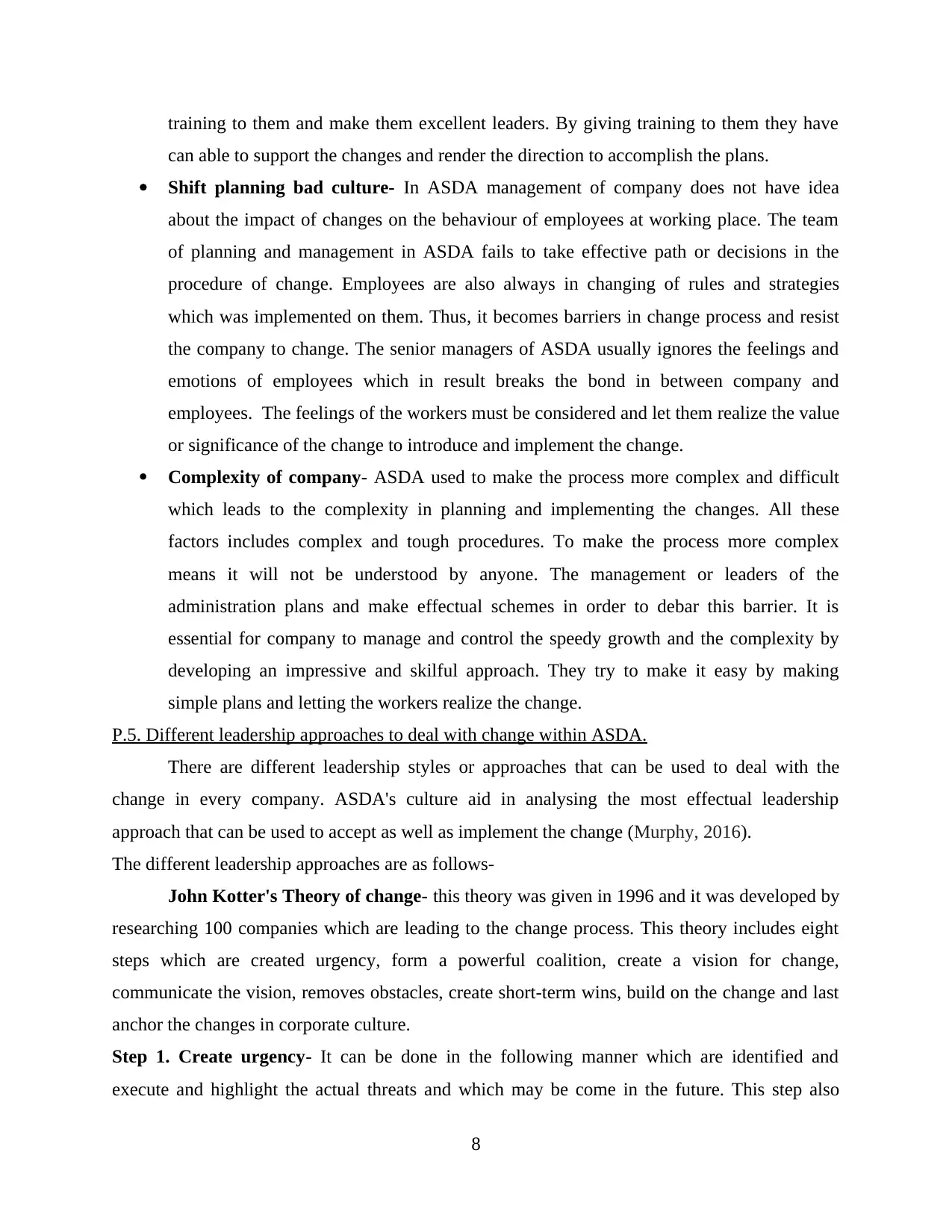
training to them and make them excellent leaders. By giving training to them they have
can able to support the changes and render the direction to accomplish the plans.
Shift planning bad culture- In ASDA management of company does not have idea
about the impact of changes on the behaviour of employees at working place. The team
of planning and management in ASDA fails to take effective path or decisions in the
procedure of change. Employees are also always in changing of rules and strategies
which was implemented on them. Thus, it becomes barriers in change process and resist
the company to change. The senior managers of ASDA usually ignores the feelings and
emotions of employees which in result breaks the bond in between company and
employees. The feelings of the workers must be considered and let them realize the value
or significance of the change to introduce and implement the change.
Complexity of company- ASDA used to make the process more complex and difficult
which leads to the complexity in planning and implementing the changes. All these
factors includes complex and tough procedures. To make the process more complex
means it will not be understood by anyone. The management or leaders of the
administration plans and make effectual schemes in order to debar this barrier. It is
essential for company to manage and control the speedy growth and the complexity by
developing an impressive and skilful approach. They try to make it easy by making
simple plans and letting the workers realize the change.
P.5. Different leadership approaches to deal with change within ASDA.
There are different leadership styles or approaches that can be used to deal with the
change in every company. ASDA's culture aid in analysing the most effectual leadership
approach that can be used to accept as well as implement the change (Murphy, 2016).
The different leadership approaches are as follows-
John Kotter's Theory of change- this theory was given in 1996 and it was developed by
researching 100 companies which are leading to the change process. This theory includes eight
steps which are created urgency, form a powerful coalition, create a vision for change,
communicate the vision, removes obstacles, create short-term wins, build on the change and last
anchor the changes in corporate culture.
Step 1. Create urgency- It can be done in the following manner which are identified and
execute and highlight the actual threats and which may be come in the future. This step also
8
can able to support the changes and render the direction to accomplish the plans.
Shift planning bad culture- In ASDA management of company does not have idea
about the impact of changes on the behaviour of employees at working place. The team
of planning and management in ASDA fails to take effective path or decisions in the
procedure of change. Employees are also always in changing of rules and strategies
which was implemented on them. Thus, it becomes barriers in change process and resist
the company to change. The senior managers of ASDA usually ignores the feelings and
emotions of employees which in result breaks the bond in between company and
employees. The feelings of the workers must be considered and let them realize the value
or significance of the change to introduce and implement the change.
Complexity of company- ASDA used to make the process more complex and difficult
which leads to the complexity in planning and implementing the changes. All these
factors includes complex and tough procedures. To make the process more complex
means it will not be understood by anyone. The management or leaders of the
administration plans and make effectual schemes in order to debar this barrier. It is
essential for company to manage and control the speedy growth and the complexity by
developing an impressive and skilful approach. They try to make it easy by making
simple plans and letting the workers realize the change.
P.5. Different leadership approaches to deal with change within ASDA.
There are different leadership styles or approaches that can be used to deal with the
change in every company. ASDA's culture aid in analysing the most effectual leadership
approach that can be used to accept as well as implement the change (Murphy, 2016).
The different leadership approaches are as follows-
John Kotter's Theory of change- this theory was given in 1996 and it was developed by
researching 100 companies which are leading to the change process. This theory includes eight
steps which are created urgency, form a powerful coalition, create a vision for change,
communicate the vision, removes obstacles, create short-term wins, build on the change and last
anchor the changes in corporate culture.
Step 1. Create urgency- It can be done in the following manner which are identified and
execute and highlight the actual threats and which may be come in the future. This step also
8
Paraphrase This Document
Need a fresh take? Get an instant paraphrase of this document with our AI Paraphraser
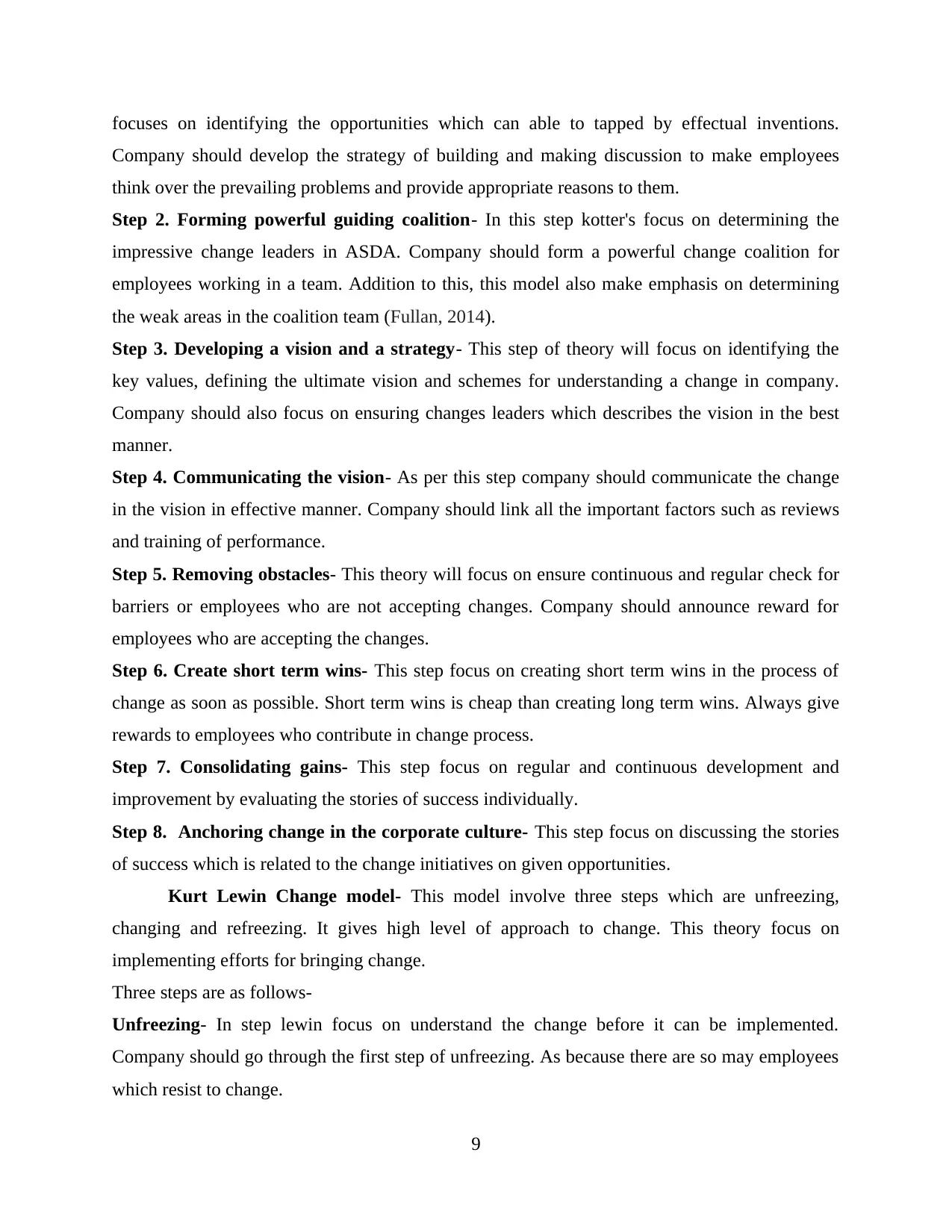
focuses on identifying the opportunities which can able to tapped by effectual inventions.
Company should develop the strategy of building and making discussion to make employees
think over the prevailing problems and provide appropriate reasons to them.
Step 2. Forming powerful guiding coalition- In this step kotter's focus on determining the
impressive change leaders in ASDA. Company should form a powerful change coalition for
employees working in a team. Addition to this, this model also make emphasis on determining
the weak areas in the coalition team (Fullan, 2014).
Step 3. Developing a vision and a strategy- This step of theory will focus on identifying the
key values, defining the ultimate vision and schemes for understanding a change in company.
Company should also focus on ensuring changes leaders which describes the vision in the best
manner.
Step 4. Communicating the vision- As per this step company should communicate the change
in the vision in effective manner. Company should link all the important factors such as reviews
and training of performance.
Step 5. Removing obstacles- This theory will focus on ensure continuous and regular check for
barriers or employees who are not accepting changes. Company should announce reward for
employees who are accepting the changes.
Step 6. Create short term wins- This step focus on creating short term wins in the process of
change as soon as possible. Short term wins is cheap than creating long term wins. Always give
rewards to employees who contribute in change process.
Step 7. Consolidating gains- This step focus on regular and continuous development and
improvement by evaluating the stories of success individually.
Step 8. Anchoring change in the corporate culture- This step focus on discussing the stories
of success which is related to the change initiatives on given opportunities.
Kurt Lewin Change model- This model involve three steps which are unfreezing,
changing and refreezing. It gives high level of approach to change. This theory focus on
implementing efforts for bringing change.
Three steps are as follows-
Unfreezing- In step lewin focus on understand the change before it can be implemented.
Company should go through the first step of unfreezing. As because there are so may employees
which resist to change.
9
Company should develop the strategy of building and making discussion to make employees
think over the prevailing problems and provide appropriate reasons to them.
Step 2. Forming powerful guiding coalition- In this step kotter's focus on determining the
impressive change leaders in ASDA. Company should form a powerful change coalition for
employees working in a team. Addition to this, this model also make emphasis on determining
the weak areas in the coalition team (Fullan, 2014).
Step 3. Developing a vision and a strategy- This step of theory will focus on identifying the
key values, defining the ultimate vision and schemes for understanding a change in company.
Company should also focus on ensuring changes leaders which describes the vision in the best
manner.
Step 4. Communicating the vision- As per this step company should communicate the change
in the vision in effective manner. Company should link all the important factors such as reviews
and training of performance.
Step 5. Removing obstacles- This theory will focus on ensure continuous and regular check for
barriers or employees who are not accepting changes. Company should announce reward for
employees who are accepting the changes.
Step 6. Create short term wins- This step focus on creating short term wins in the process of
change as soon as possible. Short term wins is cheap than creating long term wins. Always give
rewards to employees who contribute in change process.
Step 7. Consolidating gains- This step focus on regular and continuous development and
improvement by evaluating the stories of success individually.
Step 8. Anchoring change in the corporate culture- This step focus on discussing the stories
of success which is related to the change initiatives on given opportunities.
Kurt Lewin Change model- This model involve three steps which are unfreezing,
changing and refreezing. It gives high level of approach to change. This theory focus on
implementing efforts for bringing change.
Three steps are as follows-
Unfreezing- In step lewin focus on understand the change before it can be implemented.
Company should go through the first step of unfreezing. As because there are so may employees
which resist to change.
9
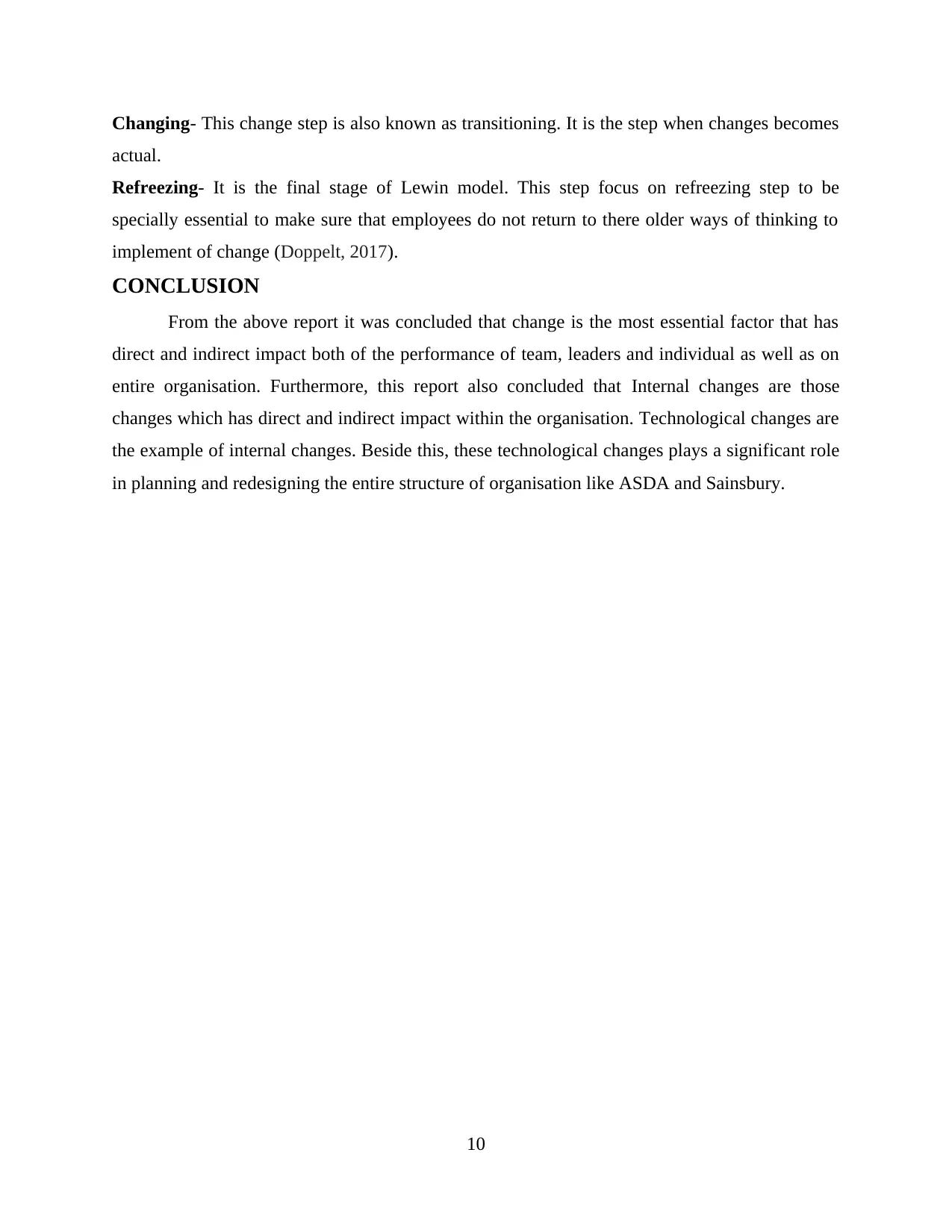
Changing- This change step is also known as transitioning. It is the step when changes becomes
actual.
Refreezing- It is the final stage of Lewin model. This step focus on refreezing step to be
specially essential to make sure that employees do not return to there older ways of thinking to
implement of change (Doppelt, 2017).
CONCLUSION
From the above report it was concluded that change is the most essential factor that has
direct and indirect impact both of the performance of team, leaders and individual as well as on
entire organisation. Furthermore, this report also concluded that Internal changes are those
changes which has direct and indirect impact within the organisation. Technological changes are
the example of internal changes. Beside this, these technological changes plays a significant role
in planning and redesigning the entire structure of organisation like ASDA and Sainsbury.
10
actual.
Refreezing- It is the final stage of Lewin model. This step focus on refreezing step to be
specially essential to make sure that employees do not return to there older ways of thinking to
implement of change (Doppelt, 2017).
CONCLUSION
From the above report it was concluded that change is the most essential factor that has
direct and indirect impact both of the performance of team, leaders and individual as well as on
entire organisation. Furthermore, this report also concluded that Internal changes are those
changes which has direct and indirect impact within the organisation. Technological changes are
the example of internal changes. Beside this, these technological changes plays a significant role
in planning and redesigning the entire structure of organisation like ASDA and Sainsbury.
10
⊘ This is a preview!⊘
Do you want full access?
Subscribe today to unlock all pages.

Trusted by 1+ million students worldwide
1 out of 14
Related Documents
Your All-in-One AI-Powered Toolkit for Academic Success.
+13062052269
info@desklib.com
Available 24*7 on WhatsApp / Email
![[object Object]](/_next/static/media/star-bottom.7253800d.svg)
Unlock your academic potential
Copyright © 2020–2025 A2Z Services. All Rights Reserved. Developed and managed by ZUCOL.





